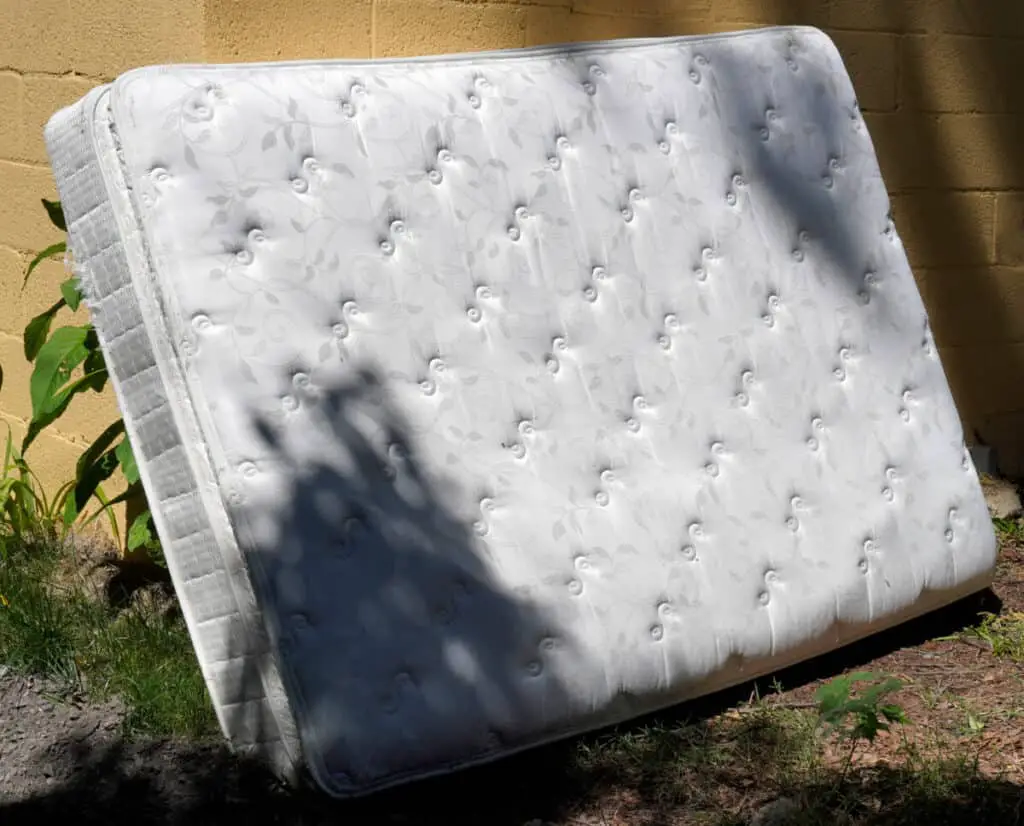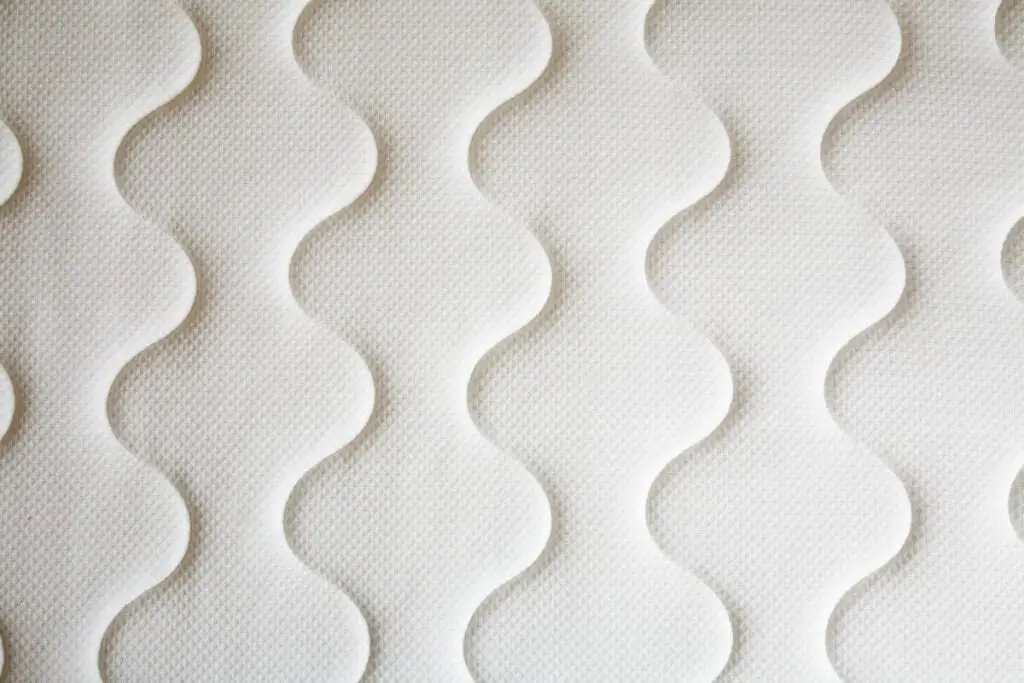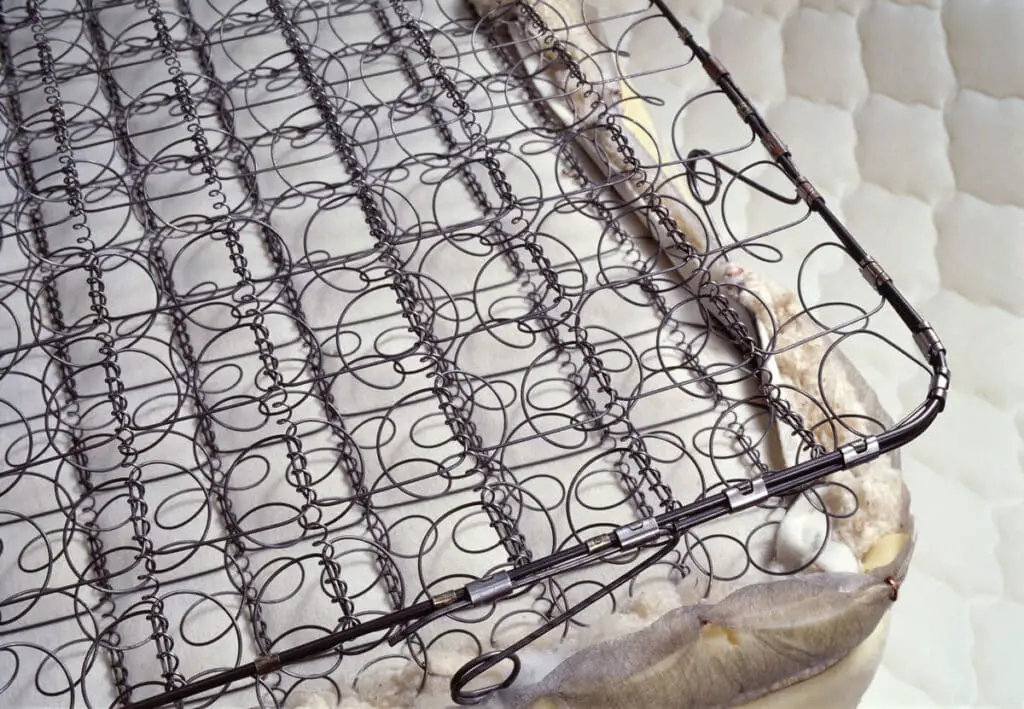
The hardest part of getting rid of a mattress should be moving it. Unfortunately, in many places finding out where to take it can end up being just as difficult if not even harder.
The best way to recycle a mattress is to schedule a time for a local mattress recycler to pick it up from a transfer point. However, in some places, it may be possible to have mattress retailers pick up old mattresses at the same time that they are delivering new ones.
But how do you know whether or not your local retailer will be able to pick up your mattress for recycling? And what happens if nobody can come to pick up your old mattress?
How To Get Your Mattress Recycled
While most mattresses end up in landfills when people are done with them, mattresses are actually made up pretty much entirely of recyclable materials such as wood, cotton, steel, and foam. Because of this, there are many organizations across the country that are willing to recycle them.
The problem is that mattresses are much too bulky to be recycled with other small recyclable household items. Because of this, you can’t just leave your old mattress out on the curb with your recycling and expect your city’s waste management to come deal with it. You’ll have to call someone on the phone.
This shouldn’t be too difficult, and you’ll have multiple options to choose between. In most of the United States, you can contact 1-800-JUNK, a waste transport company that has a contract with a mattress recycler. They’ll need your ZIP code and the date and time they’ll need to come to pick the mattress up as well as a description of the mattress you’re getting rid of.
If you’re using more locally-based measures, you’ll want to call your local waste management department, who will either schedule the pickup with you or point you towards someone who can. Usually, you will need to bring your mattress to a transfer point, where it will be picked up and taken off to a recycling center, but some places do provide curbside pickup for mattresses to be recycled.
If you live in California, Rhode Island, or Connecticut, the retailer you buy your new mattress from required to pick up and recycle your old mattress. The cost of this is included as a fee in the price of your new mattress. Follow the instructions that the retailer gives you to get your old mattress to them, and they should take care of the rest.
Depending on the retailer and location, you may be able to get this service in other parts of the country as well. In order to arrange this, you’ll need to talk to the mattress company ahead of time and ask if they’ll take mattresses for recycling. If they do, you can make arrangements with them then.
You also may be able to just take your old mattress to a recycling center yourself. You’ll probably still have to call around to find a recycling center that will accept lone mattresses, but once you do they will probably be happy to receive your mattress especially if they don’t have to haul it themselves.
The big problem with this is that you need to have a vehicle with the cargo space to safely fit a whole mattress, which can be difficult depending on what kind of mattress you’re recycling.
Why Recycle Mattresses?
Mattresses are incredibly bulky. It only takes about twenty mattresses to weigh in at a ton, and over time that weight and density will grow as the mattress absorbs more and more fluids. This means that mattresses not only take up a lot of space in landfills but also cost a lot of money to move to a landfill.
On the flipside, mattresses are filled with useful materials that can continue circulation for years to come if they are recycled. This keeps valuable natural resources in the system, and also allows companies doing the work of recycling to make money.
While there are certainly situations in which a mattress shouldn’t be recycled, for most people recycling their mattress will be the most eco-friendly and sustainable choice.
When Shouldn’t A Mattress Be Recycled?

The vast majority of mattresses should be recycled and not thrown away. The number of mattresses that end up in landfills is actually a serious problem because of the sheer amount of space they take up, and the waste of materials is in and of itself a shame.
However, mattresses with bed bugs or that are infested in other ways cannot be recycled without risking contaminating whatever they get recycled into. This is especially true of bed bugs, which are nearly impossible to fully eradicate out of a mattress once they’re in there. If you are dealing with an infestation, ask the mattress retrieval people if your mattress can be safely recycled.
Water and air-based mattresses are also difficult to recycle. While they aren’t good to throw into a landfill, not all recycling centers accept old vinyl and plastic mattresses. You should call and ask before determining to throw them into the trash, but if they say no make sure that they are fully deflated before throwing them out.
You may also consider patching up old air and water mattresses so that you can continue using them. depending on the size of the leak, you may be able to simply duct tape over it. With some careful work and testing, you may be able to bring that old thing back to life in a way that restoring a normal mattress would be impossible.
Donating Or Selling A Mattress
You may not be able to find a recycling center to recycle your old mattress or a company to take it away for you. In this case, if your mattress is still in good condition, you may be able to donate it to a thrift store or to a local cause.
You can use Donation Town to find charities in you area that will accept mattresses. These are a good place to start. They will likely have different standards for quality that they need your mattress to meet, so it’s possible that you’ll need to call more than one before you’re able to find someone who will accept it.
Do be certain that your mattress is in good enough condition for someone else to use before donating it. If it isn’t, it will either be rejected or become a burden for whatever charity you give it to. Neither of these are desirable outcomes.
The two benefits of donation are that most organizations offer free pickup and you get a tax credit based on the value of the mattress donated. These are both useful benefits, but they are negated entirely if the mattress you donate isn’t fit for donation.
If your mattress is in really pristine condition but you can’t just return it for a refund, you may be able to sell it. While it may be tough to put it on e-Bay, sites like Craigslist where buyers are local and pick up the purchased object on their own should be able to handle the sale easily.
Facebook Market and any other location-based online sale service are all options for this. You also may be able to ask your friends if they need a new mattress and if they do, you may be able to sell your old one to them. Just make sure that you can figure out a way to deal with their old one as well, or you may have just exchanged your old problem for an older, worse problem.
Repurpose The Parts
If you can’t donate your mattress and you can’t get it recycled, you may be able to break it down into parts yourself. By cutting open the fabric lining and removing the staples holding it together, you can get to the more easily recycled metal and wooden parts inside.
The metal can probably be sold to a scrapyard, and the wood can be repurposed for household projects, while the fabrics can be recycled normally.
You could alternatively use some of the paddings as a cleaning sponge, or try to turn the fabric covering into something like a rug. The materials in a mattress are all very useful if you know what you’re doing with them.
Many people have turned old mattress springs into decorations, and old memory foam can be turned into anything from a per bed to a covering for an uncomfortable wooden chair.
If you a big DIY person, a broken-down mattress can be an absolute treasure trove of cool materials to use for creative crafts. Even if you aren’t, if taking the thing apart can help keep it out of a landfill it’s worth doing.
How To Break Down A Mattress
Breaking down a mattress is not as difficult as it might seem, and it allows you to easily recycle all of the constituent materials. In order to take on this project, you’ll need a utility knife, heavy pliers, bolt cutters, a wood saw if you’re deconstructing a box spring set, and containers for all of the parts. You’ll also want to make sure that you have work gloves and protective glass to keep your body safe from vindictive mattress parts.
Take the mattress outside, where you can work without accidentally breaking something. Taking the utility knife, find the place where the piping meets the mattress and cut the thread, pulling it out of the mattress. Repeat this on the other side of the mattress to completely remove the chord. This should allow you to remove the sides from the mattress.
Next, you’ll remove the outermost layer of fabric. There will be staples binding it to the inside of the mattress, which can be removed with the plier you collected while gathering materials. Once the fabric is free, you should be able to remove it completely.
Now the cotton padding inside should be available for you to remove with your hands. If you’re wearing solid gloves, you should be able to easily sweep all of that cotton into a bag. If not, you will need to be careful not to hurt yourself on the metal underneath, which will likely have a lot of sharp bits in it that will be hard to see.
There will also be a layer of fiber on the bottom of the mattress which you can now remove. This will reveal the springs, which you can take apart by cutting with the bolt cutters.
If your mattress is made of memory foam, skip all of these steps and just cut it up with a knife. As long as you’re gentle with the cutting instrument, this should be a fairly easy process that breaks the mattress into smaller, reusable parts. When this is done, you’ll have one mattress worth of memory foam to turn into whatever you want.
Now that you have all of the parts of the mattress separated from one another, you can do whatever you want with them. Upcycling is possible with a lot of the bits, while the organic parts are all pretty easily recycled or composted. Whatever you choose to do, it’s better than taking the mattress to a landfill

What About Futons And Box Springs?
Like mattresses, box spring sets can be difficult to transport to recycling centers. Fortunately, most of the same information applies to them as to a mattress, which means that when you’re done with it if you can’t get it taken away you can always take it apart yourself. The biggest difference is that if you take it apart yourself you’ll need a way to cut up the wood after you’ve removed all the other bits.
Futon couches are even more similar to beds than box spring sets are. Because of this, you can follow the same steps as you would for a mattress to get them recycled. However, they can be more difficult to deconstruct as they are often more complicated in their construction than a mattress would be.
Related Topics:
If you like the article above, here are some other similar articles you should check out!
